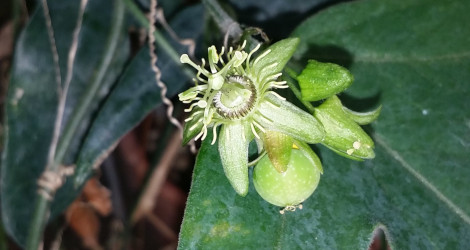Accession Data:
Passiflora suberosa L.
subg. Decaloba
- Common Name: Cork-barked Passion flower
- Family: Passifloraceae Juss. ex Kunth.
- Country of Origin: S & C America, south Pacific Islands
- Description: [syn. Passiflora angustifolia, flexuosa, glabra, globosa, hederacea, hederaefolia, heterophylla (Dryand), hirsuta, kohautiana, limbata, lineariloba, litoralis, longifolia, minima, nigra, olivaeformis, oliviformis, pallida, parviflora, peltata, puberula, tridactylites, villosa, viridis, warei
Subgenus Decaloba
Section CiecaPublication: Sp. Pl. 958 (1753)
This plant has such variable foliage that it has often been mistaken for a new species and thus the large number of synonyms noted above. This plant produces leaves that tend to change in waves as the plant grows older or taller. It has been suggested by lepidopterists that this is a defense against caterpillar attack at the early stages of the plants development, by constantly changing its leaf shape so that it is not recognizable by its predator.
This species grows wild over most of South America, Central America, the West Indies, Hawaii, New Guinea, New Caledonia, Fiji and Samoa, and two forms grow on the Galapagos Islands.
Vine glabrous or pubescent, lower stems corky. Stipules linear, 6-8 mm long. Petiole 5-40 mm long. Petiole glands 2, very small, stipitate, 0.5 mm. Leaves very variable, entire to deeply 3-lobed. Peduncle slender, 10 mm long. Bracts minute, soon deciduous. Flowers 8-30 mm wide, singly or in pairs. Sepals green or yellowish green. Petals none. Corona filaments 2 series, outer yellow and white or green and yellow. Fruit small, globose, size of a pea, dark purple blue when ripe. Propagation easy from seed or cuttings from good specimens.
In Cuba it is known as pintero or huero do gallo, in Peru as noxbe cimarron and in St. Thomas as pap bush.
- USDA Zone: 8b-11
Accession Data:
- Accession # 198500144
- Source: Unknown
- Accession Date: 12-31-1985
- Bench: 1316 - NEOA: Ground Bed 2 SE
- Currently: active - healthy
- Qty: 1 confirmed on 10-08-2024
Classification:
- Division: Magnoliophyta
- Class: Magnoliopsida
- SubClass: eurosid I
- Order: Malpighiales
- SubOrder:
- Family: Passifloraceae
- SubFamily: Passifloroideae
- Tribe: Passifloreae
- SubTribe:
Flowering Data:
This accession has been observed in bloom on:| Year | Jan | Feb | Mar | Apr | May | Jun | Jul | Aug | Sep | Oct | Nov | Dec | ||||||||||||||||||||||||||||||||||||||||
|---|---|---|---|---|---|---|---|---|---|---|---|---|---|---|---|---|---|---|---|---|---|---|---|---|---|---|---|---|---|---|---|---|---|---|---|---|---|---|---|---|---|---|---|---|---|---|---|---|---|---|---|---|
| 2025 | ||||||||||||||||||||||||||||||||||||||||||||||||||||
| 2024 | ||||||||||||||||||||||||||||||||||||||||||||||||||||
| 2023 | ||||||||||||||||||||||||||||||||||||||||||||||||||||
| 2022 | ||||||||||||||||||||||||||||||||||||||||||||||||||||
| 2021 | ||||||||||||||||||||||||||||||||||||||||||||||||||||
| 2020 | ||||||||||||||||||||||||||||||||||||||||||||||||||||
| 2019 | ||||||||||||||||||||||||||||||||||||||||||||||||||||
| 2018 | ||||||||||||||||||||||||||||||||||||||||||||||||||||
| 2017 | ||||||||||||||||||||||||||||||||||||||||||||||||||||
| 2016 | ||||||||||||||||||||||||||||||||||||||||||||||||||||
| 2015 | ||||||||||||||||||||||||||||||||||||||||||||||||||||
| 2014 | ||||||||||||||||||||||||||||||||||||||||||||||||||||
| 2013 | ||||||||||||||||||||||||||||||||||||||||||||||||||||
| 2012 | ||||||||||||||||||||||||||||||||||||||||||||||||||||
| 2011 | ||||||||||||||||||||||||||||||||||||||||||||||||||||
| 2010 | ||||||||||||||||||||||||||||||||||||||||||||||||||||
| 2009 | ||||||||||||||||||||||||||||||||||||||||||||||||||||
| 2008 | ||||||||||||||||||||||||||||||||||||||||||||||||||||
| 2007 | ||||||||||||||||||||||||||||||||||||||||||||||||||||
| 2006 | ||||||||||||||||||||||||||||||||||||||||||||||||||||
| 2005 | ||||||||||||||||||||||||||||||||||||||||||||||||||||
| 2004 | ||||||||||||||||||||||||||||||||||||||||||||||||||||
| 2003 | ||||||||||||||||||||||||||||||||||||||||||||||||||||
References (internal):
References (external):
- Passion Flowers, 2nd Ed., John Vanderplanck, 1996
- Shape Shifters at Virtual Herbarium
data regenerated on Sat, 10 May 2025 13:45:02 -0400 [bcm v4.0]
Images:

Additional images for this accession:
Click on thumbnails to enlargeCurrent Accessions in the Passifloraceae
Subfamily Passifloroideae
Tribe Passifloreae
- Adenia globosa
- Adenia repanda

- Passiflora biflora

- Passiflora boenderi

- Passiflora coriacea


- Passiflora edulis 'Possum Purple'
- Passiflora incarnata

- Passiflora lutea


- Passiflora misera
- Passiflora pardifolia


- Passiflora racemosa

- Passiflora suberosa

- Passiflora trifasciata

Subfamily Turneroideae
W/C = Wild Collected = indicates flowering in past 14 days
= indicates flowering in past 14 days
 = images available for this accession
= images available for this accession
 = map available for this accession
= map available for this accession
 = accession added within past 90 days
= accession added within past 90 days
